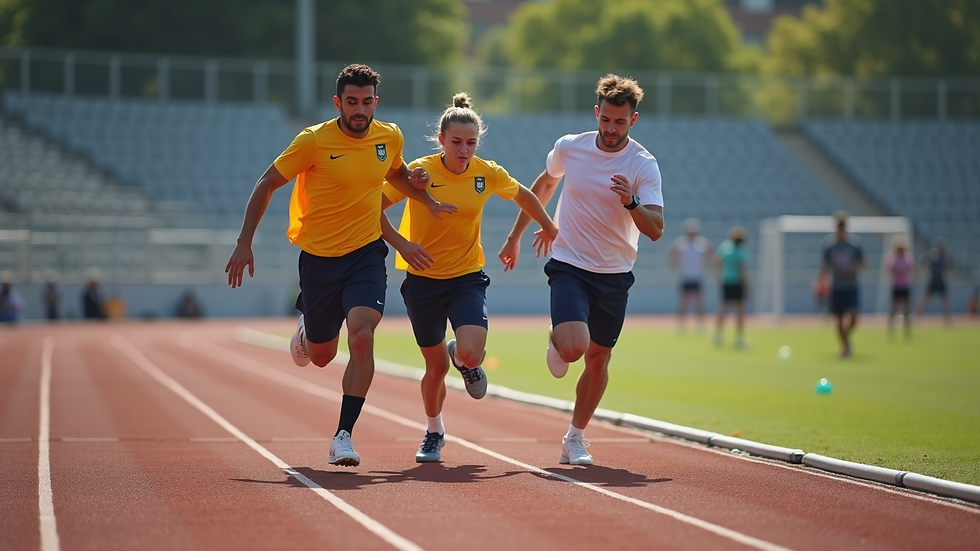Boost Your Skills with Athlete Performance Training
- Jaey Marchaille Silva
- Sep 24
- 3 min read
When you want to push your limits and reach new heights in your physical abilities, focusing on athletic performance optimization is the key. It’s not just about working harder; it’s about training smarter. I’ve learned that the right approach can transform your strength, speed, and endurance. Let me walk you through how to boost your skills effectively and sustainably.
Why Athletic Performance Optimization Matters
Athletic performance optimization is about fine-tuning every aspect of your training to get the best results. It’s not a one-size-fits-all solution. Instead, it’s a personalized plan that targets your weaknesses and builds on your strengths. When you optimize your performance, you reduce injury risk, improve recovery, and enhance your overall athletic ability.
Think of it like tuning a high-performance car. You don’t just add more fuel; you adjust the engine, tires, and suspension to get the best output. The same goes for your body. You need to balance strength, flexibility, speed, and endurance.
Here’s what I focus on to optimize performance:
Strength training to build muscle power
Speed drills to improve quickness and reaction time
Mobility exercises to increase range of motion
Recovery techniques to prevent burnout and injury
By combining these elements, you create a solid foundation for success.

Step-by-Step Guide to Athletic Performance Optimization
Let’s break down the process into clear, actionable steps. Follow these to get the most out of your training sessions.
1. Assess Your Current Fitness Level
Start by understanding where you stand. Perform basic tests like sprint times, vertical jump height, and max lifts. This baseline helps you track progress and identify areas needing improvement.
2. Set Clear, Measurable Goals
Goals keep you motivated and focused. Instead of vague aims like “get stronger,” set specific targets such as “increase squat max by 20 kg in 8 weeks” or “improve 40-meter sprint time by 0.5 seconds.”
3. Design a Balanced Training Plan
Your plan should include:
Strength workouts 3-4 times a week
Speed and agility drills 2-3 times a week
Flexibility and mobility sessions daily or every other day
Rest and recovery days to allow your body to heal
4. Track Your Progress
Keep a training journal or use an app to log workouts, weights, times, and how you feel. This data helps you adjust your plan and stay accountable.
5. Prioritize Nutrition and Hydration
Fuel your body with the right nutrients. Focus on lean proteins, complex carbs, healthy fats, and plenty of water. Proper nutrition supports muscle growth and energy levels.
6. Incorporate Recovery Strategies
Use foam rolling, stretching, ice baths, or massages to speed up recovery. Sleep is also crucial - aim for 7-9 hours per night.
By following these steps, you’ll see steady improvements and avoid common pitfalls like overtraining or injury.

Unlocking Your Potential with Expert Coaching
Sometimes, you need more than just a plan. Expert coaching can make a huge difference. Coaches bring experience, motivation, and personalized feedback that you can’t get on your own.
I recommend seeking out professionals who specialize in athletic performance optimization. They can:
Analyze your movement patterns
Correct your form
Tailor workouts to your specific sport or goals
Provide mental strategies to boost confidence and focus
One great resource I found is athlete performance training. Their approach combines science and practical experience to help athletes unlock their full potential. Working with experts like these accelerates your progress and keeps you on the right track.

Practical Tips to Stay Consistent and Motivated
Consistency is the secret sauce of athletic performance optimization. Here’s how I keep myself on track:
Set mini-goals for each week to stay focused
Mix up workouts to avoid boredom
Find a training partner for accountability
Celebrate small wins to boost morale
Visualize success before each session
Remember, progress takes time. Don’t get discouraged by setbacks. Instead, learn from them and keep pushing forward.
Building Mental Toughness Alongside Physical Strength
Physical skills are important, but mental toughness often separates good athletes from great ones. Developing resilience, focus, and a strong work ethic is part of athletic performance optimization.
Practice these mental strategies:
Positive self-talk to overcome doubts
Goal visualization to stay motivated
Mindfulness and breathing exercises to manage stress
Embracing challenges as opportunities to grow
By strengthening your mind, you’ll handle pressure better and perform at your best when it counts.
Athletic performance optimization is a journey, not a quick fix. With the right mindset, expert guidance, and a solid plan, you can boost your skills and reach new levels of strength and speed. Start today, stay committed, and watch your potential unfold.



Comments